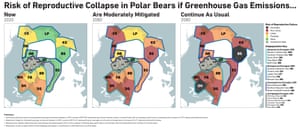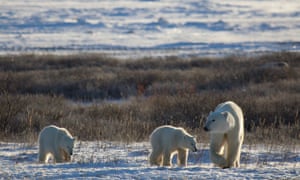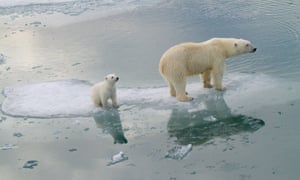Melting Arctic sea ice could cause starvation and reproductive failure for many as early as 2040, scientists warn.
Scientists have predicted for the first time when, where and how
polar bears are likely to disappear, warning that if greenhouse gas
emissions stay on their current trajectory all but a few polar bear
populations in the Arctic will probably be gone by 2100.
By as early as 2040, it is very likely that many polar bears will begin to experience reproductive failure, leading to local extinctions, according to a study published in Nature Climate Change.
The study examines how the bears will be affected under two different greenhouse gas emissions scenarios. The researchers found that under a business-as-usual emissions scenario, polar bears will likely probably only remain in the Queen Elizabeth Islands – the northernmost cluster in Canada’s Arctic archipelago – at the end of the century. And even if greenhouse gases are moderately mitigated, it is still likely that the majority of polar bear populations in the Arctic will experience reproductive failure by 2080.

By as early as 2040, it is very likely that many polar bears will begin to experience reproductive failure, leading to local extinctions, according to a study published in Nature Climate Change.
The study examines how the bears will be affected under two different greenhouse gas emissions scenarios. The researchers found that under a business-as-usual emissions scenario, polar bears will likely probably only remain in the Queen Elizabeth Islands – the northernmost cluster in Canada’s Arctic archipelago – at the end of the century. And even if greenhouse gases are moderately mitigated, it is still likely that the majority of polar bear populations in the Arctic will experience reproductive failure by 2080.

“It’s been clear for some time that polar bears are going to suffer under climate change,” said Péter Molnár, a biologist at the University of Toronto Scarborough, and lead author of the study. “But what was not fully clear was when we would expect major declines in the survival and reproduction of polar bears that could ultimately lead to their extirpation. We didn’t know whether that would happen early or later in this century.”

“Even if we mitigate emissions, we are still going to see some subpopulations go extinct before the end of the century,” Molnár said. This includes the polar bears in the vulnerable, southernmost ice areas of western Hudson Bay, Davis Strait, and southern Hudson Bay. “But we would have substantially more populations persisting by the end of the century, even with reduced reproduction, compared with a business-as-usual emissions scenario.”
The study examined 13 of the world’s 19 polar bear subpopulations, accounting for 80% of the total population of the species. Bears inhabiting an area known as the Archipelago ecoregion in the Canadian Arctic were not included as the geography of the area – islands and narrow channels – made it too difficult to predict future ice extent.
Of those studied populations, polar bears in southern Hudson Bay and Davis Strait in Canada are “very likely” to experience reproductive failure by 2040 in a scenario of unmitigated emissions. Polar bears in much of Alaska and Russia will be in serious trouble by 2080. And by 2100, it’s inevitable that these populations will experience reproductive failure, leading to extinction if countries don’t drastically reduce emissions of heat-trapping gases.

“It shows where we would expect to see increased human-bear conflict,” said Andrew Derocher, a biology professor at the University of Alberta who heads the Polar Bear Science Lab and is unaffiliated with the study. Not all Arctic communities have programmes in place to deal with more polar bears in their localities. And there is a moral question of whether humans should help struggling bears.
“With something like polar bears, where you’re not going to get their habitat back, it’s not clear we’re going to try to hold on to these populations everywhere. If we start to see a large number of bears on land dying of starvation, what kind of interventions would we get into?”
Derocher said polar bear managers needed to work out whether they would provide supplementary feed for the bears, or relocate them to regions that still had ice.
“You look at the fallout from one video of a starving bear. Well, imagine going to Churchill, Manitoba – a hub of polar bear tourism – and seeing 50 bears walking around like that. The public outcry is going to be intense and managers need to be thinking about what their policies are going to be now.”
Find more age of extinction coverage here, and follow biodiversity reporters Phoebe Weston and Patrick Greenfield on Twitter for all the latest news and features
.png)

No comments:
Post a Comment